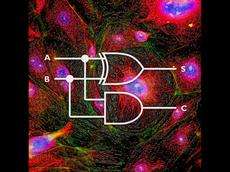Molecular algebra in mammalian cells

(Phys.org) -- Mammalian cells can now do what an electronic calculator can: perform logical calculations. Swiss researchers have equipped cells with a complex genetic network that can do more than just one plus one.
A team of researchers from ETH Zurich headed by Martin Fussenegger, a professor of biotechnology and bioengineering at ETH Zurich’s Department of Biosystems in Basel, has constructed a gene network that can perform logical operations and, as a result, initiate specific metabolic steps. “We have developed the first real cellular calculator,” says Fussenegger.
Using biological components, the researchers developed a set of different elements that can be interconnected in different combinations and subsequently perform logical operations. These circuit elements, which are known as “logic gates” in the jargon, use the apple molecule phloretin and the antibiotic erythromycin as input signals. The calculations performed are based on Boolean logic.
Calculator with modular structure
The researchers created several “gates” from biological components, such as the AND gate, which is also referred to as an AND operator in computer technology. In the case of an AND gate, both inputs – namely phloretin and erythromycin – need to be present for a one to be calculated in the output. Based on this one, the gene network triggers the formation of a fluorescent protein, which makes the cell glow. If one of the two input signals is lacking, the cell will not light up.
By combining and interconnecting several logic gates, the biotechnologists ultimately obtained a “half-adder” or “half-subtractor”, both central circuit elements in computer technology. A half-adder is a basic digital circuit that adds up two binary numbers; the half-subtractor, on the other hand, deducts them. These two elements are found in every digital calculator, where they perform most calculations. In cell-structure experiments, the two bio-computer components produced solid results.
The first “true” programmable cell calculator
“By combining several logic gates, we have achieved an unprecedented level of complexity in the synthetic gene network in cells,” stresses Professor Fussenegger. Moreover, it is remarkable that the bio-computer can process two different input and output signals in parallel. This sets the bio-computer apart from digital electronics, as this only works with electrons.
“Of course, our cell calculator is nowhere near as efficient as a PC,” says the ETH-Zurich professor. “By nature, however, a cell can process many different metabolic products in parallel.” Even though the biological calculator has only been able to master basic binary arithmetic operations thus far, “It is wonderful that a mammalian cell can calculate like that”, beams Professor Fussenegger.
Other scientists have already realised diverse circuit elements in yeasts and bacteria. In the new system, however, everything is present in one cell, and a mammalian one that easily outstrips the yeasts and bacteria in terms of complexity at that.
Future applications conceivable
The researchers have thus come closer to a therapeutic application than by changing bacteria or yeast cells. For Professor Fussenegger, it is conceivable that implanted cell calculators could monitor a patient’s metabolism in the distant future and step in if necessary. These intelligent cell implants could be used in diabetes patients, for instance, by developing a circuit that recognises disease-related metabolic products and controls the release of therapeutically effective substances, such as insulin. However, the researchers are still a far cry from such an application.
The idea of the cell calculator came from Fussenegger’s doctoral student Simon Ausländer. In the Basel-based professor’s lab, it fell upon fertile ground as he already had the necessary components to build the calculator. “That’s the beauty of synthetic biology: we can simply delve into the toolbox and create new functionalities.”
More information: Ausländer S, et al. Programmable single-cell mammalian biocomputers. Nature, Advanced Online Publication, 3rd June 2012. DOI: 10.1038/nature11149
Journal information: Nature
Provided by ETH Zurich


















